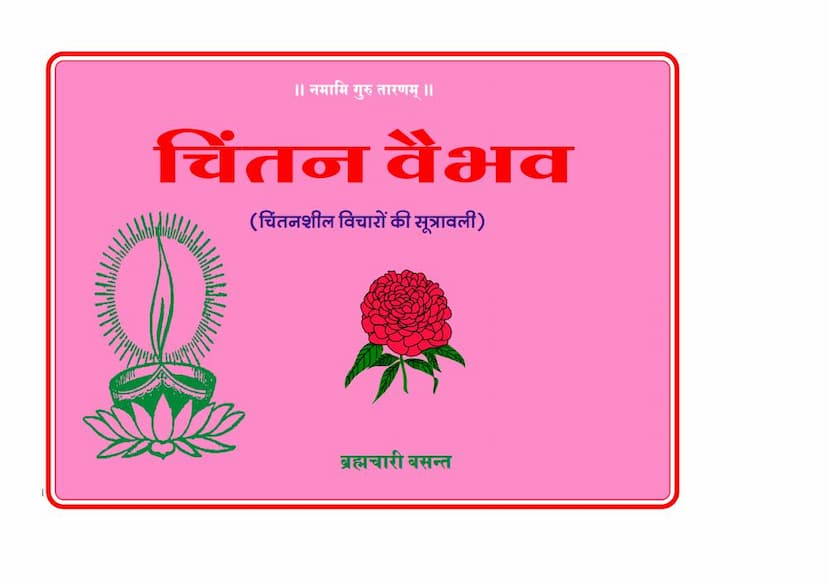Chintan Vaibhav
Added to library: September 1, 2025

Summary
Here's a comprehensive summary of the Jain text "Chintan Vaibhav" by Brahmachari Basant, focusing on its core teachings and philosophical insights:
Overview:
"Chintan Vaibhav" (Splendor of Contemplation) is a collection of insightful thoughts and aphorisms attributed to Brahmachari Basant and published by Bramhanand Ashram. The book, presented in Hindi with English translations, serves as a guide to spiritual contemplation and self-realization, drawing heavily on Jain philosophy. It offers profound advice on living a meaningful life, understanding the nature of the self, and achieving liberation.
Key Themes and Teachings:
The text emphasizes a journey of self-discovery and spiritual upliftment through various spiritual principles and practices. Here are the main themes:
-
The Nature of the Self and Reality:
- The Soul is Immortal and Eternal: The body is temporary, but the soul (Atman) is immortal, eternal, and pure consciousness. Identifying with the soul, not the body, is crucial for immortality.
- The Soul is Supreme Spirit: The soul is inherently pure, blissful, and of the nature of pure consciousness. It is the divine essence within, the "Supreme Spirit" or "Paramatma."
- Reality vs. Illusion: The world and its transient pleasures are considered illusory. True reality lies in the eternal nature of the soul. Attachments to worldly objects are the root cause of suffering.
- The Nature of Existence: True existence ("Sat") is eternal and unchanging, while non-existence ("Asat") never truly exists. The universe undergoes transformation (Paryayi Parinamana), but the essence of substances remains constant.
-
Living a Virtuous Life:
- The Importance of the Present: Dwelling on the past or worrying about the future is futile. Living in the present moment, as a witness, is the secret to a meaningful life.
- Detachment and Non-Possession (Aparigraha): The concept of "mine" (mam) leads to attachment, worry, and fear. Renouncing this sense of possession ("na mam") leads to detachment and liberation.
- Righteous Conduct (Achar, Vichar, Kriya): Following the path of right faith, right knowledge, and right conduct is essential for spiritual progress. These are the cornerstones of Jain practice.
- The Golden Rule: Treat others as you wish to be treated. Do not do to others what you do not wish for yourself. This is the essence of religion.
- The Power of Forgiveness: Anger is a destructive force, like fire, while forgiveness is a cooling balm. Forgiveness is considered the highest religion and a key to peace.
- Simplicity and Humility: Simplicity is a divine quality that leads to elegance and inner peace. Humility is the gateway to knowledge and spiritual progress, while arrogance leads to downfall.
- Truthfulness: Speaking the truth makes one trustworthy and respected. Lies, however small, have severe consequences and lead to downfall.
- Non-Violence (Ahimsa): Ahimsa, along with truth, non-stealing, celibacy, and non-possession, forms the core of human religion and is applicable to all beings.
-
Overcoming Hindrances to Spiritual Growth:
- The Destructive Nature of Ego and Pride: Ego (Ahankar) is the greatest obstacle, obscuring the divine within. It leads to downfall, loss of virtues, and prevents one from recognizing the true self.
- Mind as a Monkey: The mind is described as restless and volatile, like a monkey, and prone to desires. It needs to be controlled through knowledge, meditation, and self-discipline.
- Ignorance (Agyan) as the Root of Suffering: Ignorance of the true self and attachment to the material world are the primary causes of suffering, birth, and death.
- The Dangers of Greed and Desire: Greed and insatiable desires lead to unhappiness, anxiety, and a cycle of suffering. They are the root of many sins and hindrances to spiritual progress.
- The Power of Penance (Tap): Penance, through self-discipline, control of desires, and absorption in the true self, purifies the soul, destroys negative karma, and leads to liberation.
- The Importance of Self-Control (Sanyam): Restraint over the senses, mind, and actions is crucial for progress and protection of one's spiritual path. It is the foundation of a disciplined life.
-
Spiritual Practice and Liberation:
- Meditation and Contemplation: Regular contemplation of the self, the nature of reality, and spiritual truths is essential for inner peace and self-realization.
- True Knowledge vs. Mere Information: True knowledge is not just about acquiring information from scriptures but understanding the essence of reality and the self, and living by that understanding.
- The Path of Liberation: Liberation (Moksha) is achieved through the realization of one's true self, detachment from worldly illusions, control of the mind and senses, and the practice of virtues.
- The Role of a True Guru: A true Guru is one who has achieved self-realization and guides others towards liberation. They are the boat that helps cross the ocean of the world.
Key Philosophical Concepts:
- Bhedgyan (Discrimination): The ability to differentiate between the self (soul) and the non-self (body, senses, external objects) is a foundational principle.
- Samveg (Spiritual Yearning/Enthusiasm): A deep yearning for spiritual liberation and a drive to practice righteousness.
- Virag (Detachment): Freedom from attachment to worldly pleasures and objects.
- Aparigraha (Non-possession): Renunciation of excessive accumulation and attachment to possessions.
- Moksha (Liberation): The ultimate goal of spiritual life, achieving a state of eternal bliss and freedom from the cycle of birth and death.
Overall Message:
"Chintan Vaibhav" is a profound spiritual guide that encourages readers to look inward, understand the ephemeral nature of the material world, and focus on the eternal essence of the soul. It provides practical wisdom for navigating life's challenges with equanimity, virtue, and a steadfast commitment to spiritual practice, ultimately leading towards self-realization and liberation. The book emphasizes that true happiness lies not in external possessions or worldly achievements but in the inner peace and understanding of one's true spiritual nature.